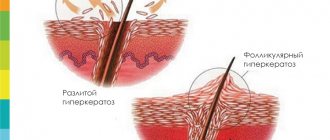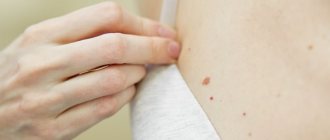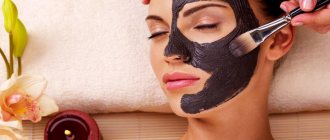Yellow facial peeling is aimed at increasing the activity of youth fibroblast cells, which secrete collagen, which ensures skin elasticity.
The main active ingredient in peeling is vitamin A (retinol), which is considered the best remedy for getting rid of signs of aging and skin aging. Previously, vitamin A was used as a drug to treat acne, but after the anti-aging effect characteristic of retinol was noticed, the latter began to be used for the purpose of rejuvenation.
Yellow peeling is different in that it is not as traumatic and aggressive as other types of peeling, and does not cause such harm to the epidermis. A complex of beneficial acids combined with vitamins A and C has a beneficial effect on skin health.
The benefits and harms of the retinol component for pregnant women
Retinol is the main component of yellow (retinol, retinoic) peeling; during pregnancy, it can have both beneficial and harmful effects on the body of the expectant mother and child. In small doses, this vitamin is beneficial, but its excess can have adverse consequences.
Retinol has the ability to rapidly accumulate in tissues and organs, especially in the liver; for this reason, its dosage must be carefully monitored during pregnancy.
The benefit is as follows: this vitamin takes an active part in the synthesis of red blood cells. Blood cells transport oxygen and nutrients to tissues. Thanks to this, the fetus receives the optimal amount of microelements.
Retinol promotes the proper formation of important systems:
- cardiovascular;
- respiratory;
- bone;
- circulatory
Vitamin A is needed for proper development:
- organs of vision;
- brain and spinal cord;
- kidney
The substance provides support for a woman’s immunity during pregnancy and protects against pathogenic microorganisms. Retinol accelerates the regeneration of epidermal cells, which plays an important role during the recovery period after childbirth.
But even a slight excess of the dosage is fraught with the risk of premature aging of the placenta and the development of pathologies in the fetus. Approximately 2-3 months before planning a pregnancy, you need to abandon procedures aimed at rejuvenating the skin if retinol is used during them. This also applies to taking complexes containing this vitamin.
We recommend: What is a peeling mitten, how to make it yourself? Top 5 best ready-made products
Excess retinol in the body of a pregnant woman leads to damage to the internal organs of the fetus. The ones who suffer the most are:
- child's limbs;
- heart;
- reproductive and nervous systems;
- kidneys
Excessive amounts of retinol entering the body reduce the effect of vitamin D and provoke its deficiency.
What kind of peeling and when is it better to do it?
You can renew your skin in a variety of ways, choose the one that suits you in all respects.
Chemical peeling
They all work to renew and exfoliate, but each acid has its own characteristics and bonus effects. Peeling is usually prescribed in courses and solves the following problems:
Acid peeling for face
- acne;
- increased skin greasiness;
- pigmentation;
- dullness;
- uneven terrain;
- wrinkles;
- loss of elasticity;
- dryness.
Mechanical
Mechanical peelings include microdermabrasion, which is carried out using abrasive particles of different origins. A classic of the genre is aluminum oxide, which provides a fairly powerful effect, but this technique has now been replaced by acids. Today, dermabrasion is used only as part of a facial treatment, in a very mild form.
Mechanical peeling
Laser
An alternative to medium acid peeling. Deeply renews the skin by piercing it with thousands of laser needles. The procedure should be used in case of obvious age-related changes and skin defects. Requires a rehabilitation period.
Ultrasonic
Ultrasonic waves and a special spatula are the arsenal of a specialist who carries out “deep” cleansing of the face, at the same time promoting the renewal of the skin.
According to the rules, any peelings are carried out in the autumn-winter period, when the sun is inactive. Having lost the top layer, the skin becomes extremely vulnerable to external influences, especially to ultraviolet radiation. After peeling procedures, the risk of hyperpigmentation increases, so the use of a cream with SPF of at least 30 is mandatory.
Effect on the embryo
Doctors are of the opinion that retinoids have a teratogenic effect, they negatively affect the process of fetal formation and provoke developmental pathologies.
For this reason, professionals from the beauty industry are trying to find out whether a woman has pregnancy plans in the near future and whether she is breastfeeding.
There are no scientifically proven facts that retinol, which penetrates into the body of the expectant mother from peeling preparations, provokes mutations in the fetus. But it was found that retinoic acid molecules have the ability to penetrate cell membranes and contact proteins in the cell nuclei. This process does not affect the transport of genetic chains from the mother to the baby’s body.
The amount of retinoic acid in the peel may not be enough to transform the genetic code.
Tests on the effects of retinoids on the fetus were performed exclusively on mice in laboratory conditions. No facts have been found to prove the teratogenic effect of vitamin A and its artificial analogues.
Pregnant women have never been tested for fetal pathologies under the influence of retinoic acid. For this reason, pregnancy and lactation are included in the list of contraindications for yellow peeling. In this case, doctors play it safe.
Summary
Post-peeling peeling is a typical and constant phenomenon that accompanies almost every exfoliation session. This process indicates the launch of skin renewal processes and the elimination of dead layers of the epidermis. The intensity of exfoliation depends on many factors: the type of peeling, the characteristics of the skin and the woman’s body. In addition, the skill of the cosmetologist and the absence of possible contraindications play an important role.
The duration of peeling depends on proper skin care. Usually the process does not last longer than 1 or 2 weeks. In cases where the skin does not return to normal for a long time, it is necessary to consult a cosmetologist.
Many women who visit a cosmetologist's office are afraid that peeling will appear on the skin after peeling. For this reason, most of them simply avoid such a procedure. The number of fans of medium peeling increases every year. This procedure, when performed correctly, benefits the skin, improves its structure and color, helps restore tone, eliminates pigmentation and fine wrinkles on the face.
The procedure itself is characterized by the following process - an active acid (often fruit) penetrates deep into the epidermis and becomes an impetus for the natural regeneration of the skin. During the first time after the procedure, the skin may turn red, begin to peel, or even swell. The skin recovery time is about a week (in each case it is individual).
Negative effects on the mother's body
A pregnant woman may develop an allergy after a yellow peeling procedure. A similar reaction is caused by components in peeling products.
Important! If a woman still decides to undergo this procedure, despite her situation, she must undergo an allergy test.
A drop of the product is applied to the wrist or the inner bend of the elbow. Usually an allergy, if any, appears after a quarter of an hour. The absence of itching or redness means that the peeling product will not cause an allergic reaction.
We recommend: Effective cleansing and rejuvenation of the skin using peeling. Pros and cons of this procedure
In addition to allergies, a woman during pregnancy may experience headaches due to an excess amount of retinol in the body. Other negative consequences include:
- swelling;
- liver dysfunction;
- fragility of hair and nails.
Contraindications to the procedure
Although retinoic peeling is gentle on the skin, it still has a chemical composition and is not suitable for everyone. Contraindications for peeling:
- Intolerance to substances included in the composition, including vitamin C;
- Presence of warts, papillomas in the place where peeling is supposed to be applied
- Violation of skin integrity;
- Lactation period or pregnancy;
- Radiation therapy;
- Allergy;
- Taking antibiotics two weeks before the start of the course;
- Somatic diseases.
Is it possible to use retinol when planning conception?
Combining yellow peeling and planning conception is also not recommended. It is worth considering other options for solving skin problems.
Doctors believe that the procedure using drugs that contain retinol is not as dangerous at the stage of pregnancy planning as at the stage of gestation. But it is important to remember that the risk of developing pathologies in the fetus under the influence of retinol can be completely eliminated only by completely abandoning such cosmetic manipulation.
Aggressive facial cleansing done in the weeks before pregnancy can cause miscarriage or premature birth. Other types of peeling are allowed at the planning stage.
Attention! At the stage of preparation for motherhood, avoid any aggressive effects on the epidermis. For those who want to successfully carry and give birth to a healthy baby, it is better not to take risks.
Skin is peeling - what to do?
This process is normal after a cosmetic procedure. This is a sign that the procedure was performed correctly and the process of cell regeneration has already begun. There is no need to be afraid or panic at the sight of flaky skin. When the skin is exposed to aggressive substances, the top layer of the epidermis is practically removed through peeling. Dead cells are removed, new, young and healthy ones appear. In the case of superficial peeling, peeling is not pronounced and disappears a day after the procedure. After the mid-peel, the top layer of skin peels off, which begins a few days later and continues throughout the recovery period.
Uniform darkening of the skin, which goes away on its own after exfoliation (after 1-2 weeks).
There is no need to rip off pieces of what has peeled off. To speed up this process, you should follow the recommendations of cosmetologists and properly care for your skin. This will ensure uniform and painless exfoliation, after which there will be no scars or pigment spots. For skin care, use creams containing Panthenol, fatty creams, and thermal water for washing. All these products help improve the protective functions of the skin and give it the missing moisture for optimal cell regeneration. There is no need to be afraid to visit a cosmetologist's office. All consequences are individual and, if the procedure is carried out correctly, are minimal.
Peeling is rightfully considered an integral element of complete skin care.
After all, this procedure helps to get rid of small wrinkles in a short time.
Let's figure out what this procedure is, how and how many times retinoic peeling can be done, and whether it is possible to use yellow cleansing when planning a pregnancy.
How long after the procedure can you not become pregnant?
A course consisting of 4–6 peeling sessions using products containing retinol forms a vitamin reserve in the skin; it lasts for about 3 months.
During this time, the epidermis will contain retinoic acid molecules, which promote visual rejuvenation.
The effect of yellow peeling lasts longer than other procedures aimed at skin rejuvenation that have a superficial effect.
For a normal pregnancy after yellow peeling, at least three months must pass before the planned conception.
If a woman is going to get pregnant and soon become a mother, she should refrain from retinoic exfoliation and replace the procedure with another one, for example, multi-fruit or milk peeling.
We recommend: 4 types of peeling after Botox: is it possible to do peeling and when, what do cosmetologists advise?
What is yellow peeling?
The procedure itself is absolutely safe for a woman, but only on the condition that the girl is not in an “interesting position”, the result of cleaning can be observed after just one procedure, and the most noticeable effect is achieved after several skin cleansings. Many women describe only positive results in reviews of this peeling, as the procedure helped make the skin smoother, softer, cleaner and more moisturized.
But it is important to remember that any chemical composition can ultimately harm not only the woman’s health, but also the development of the baby. Below we will take a closer look at the composition of this peeling, so that expectant mothers understand what components the skin cleansing mixture is made of, as well as how it can ultimately affect pregnancy.
This peeling is often called yellow, the whole point is that the composition applied to the skin has a rich yellow color, the main component of the cleaning composition is retinol, that is, a common vitamin A. But in the composition you can see not only retinol, but also other types of components that may ultimately have an adverse effect on the development process of the fetus.
To begin with, the composition contains ascorbic acid, azelaic, kojic and phytic acids are also present. Looking at this composition, it is simply impossible to imagine that this peeling could harm the unborn baby, but in some situations the substances can affect the growth and development of the baby in the womb .
Opinion and advice of cosmetologists
Cosmetologists do not recommend doing yellow peeling during pregnancy. This procedure should also be avoided during lactation.
Doctors advise avoiding cleansing your face in this way even at the stage of pregnancy planning. Experienced professionals usually refuse to perform this procedure on clients expecting the birth of a child.
But this does not mean that pregnant women should refuse to visit a cosmetologist altogether. The specialist will recommend another procedure that will tidy up your facial skin without harming the fetus.
It is undesirable for pregnant women to undergo retinoic exfoliation. This cosmetic procedure has many advantages, but there are also side effects. During pregnancy, it is better not to take risks and postpone it for several months.
Indications for retinoic peeling
- insufficient collagen production;
- poor skin moisture;
- small expression wrinkles;
- loose skin;
- skin pigmentation;
- hyperpigmentation from ultraviolet exposure;
- acne;
- skin aging;
- hyperkeratosis;
- skin contamination.
Retinoic peeling slows down the aging process, improves the structure of the skin, and evens out its relief. The procedure has an antioxidant and anti-inflammatory effect. After peeling, the skin brightens and noticeable rejuvenation occurs.
Make a retinoic (yellow) peeling
Chemical yellow peeling will restore softness and elasticity to the skin, reduce pigmentation, and smooth out scars. The method has almost no contraindications and has minimal rehabilitation. To schedule a consultation with a specialist, call us or leave your phone number
Leave your phone number. The clinic administrator will call you back.
Make an appointment











